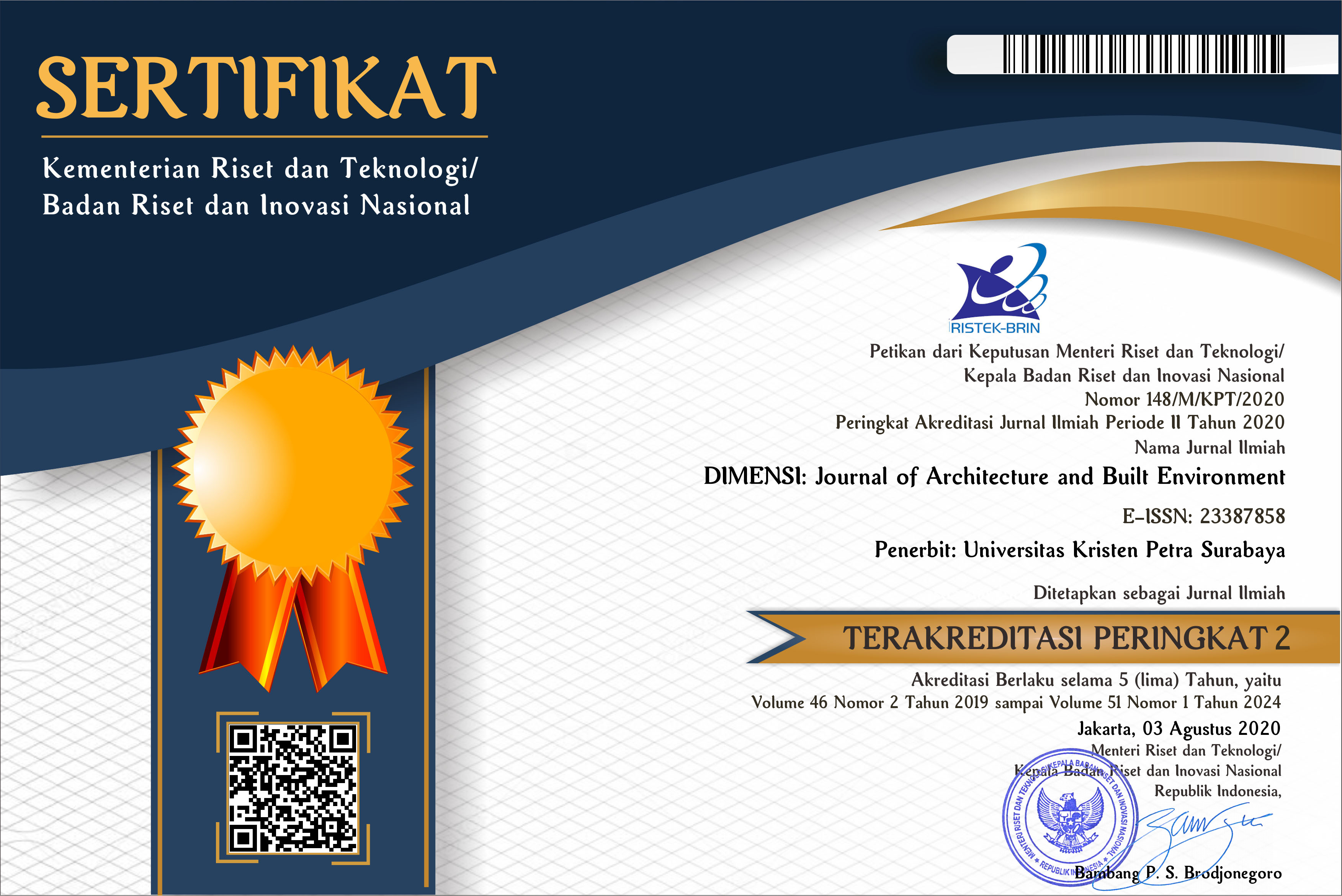TRANSFORMASI ARSITEKTUR BALE DAJA
 :
:
https://doi.org/10.9744/dimensi.36.1.pp.%2035-42
Keywords:
bale daja, transformationAbstract
Bale Daja is a building sited in kaja (northerly) direction which is defined in accordance to local terms. Kaja or Daja has been tied with a hilly (mountainous) area, lining along Bali’s east to west axis. To those reside on the southern part of this line, northerly is insequence with the actual north direction. However, those stand on the opposite side have their notherly pointing to the actual south direction. Bale Daja has various inherent functions. These include its usages as a sleeping area, space for giving birth, quarantine area for female teenagers, and storage for valuable family belongings. In a long run, these usages have been expanded to incorporate further functions of a building for sleeping, numerous domestic activities, chatting, offering preparation, reading and writing manuscripts, welcoming guests, and meeting with both local and government officers. According to a thorough investigation, there are seven types of Bale Daja found. In several cases within its development, a Bale Daja has been completed with one or more additional uses of a toilet, a modern working space, and a room dedicated for watching television. Such type of a Bale Daja is usually accessed through its sides with windows and wide openings attached. These changes are also accompanied by the use of newly available building materials. This writing examines the development of Bale Daja viewed from Balinese Traditional Architecture principles through transformation, both-and phenomenon and resultant of complexity. The recent transformation of a Bale Daja shows a trend in which traditional value systems and architectural guidelines remain highly regarded in practice. Thus, such an architectural development demonstrates a capacity to accommodate social development taking place within its society Abstract in Bahasa Indonesia: Bale daja merupakan bale yang mengikuti perletakan sesuai dengan arah mata angin dalam penyebutan masyarakat setempat. Kaja atau daja merupakan daerah yang lebih tinggi (baca: gunung); untuk Bali Selatan merupakan sebutan bagi arah utara dan untuk Bali Utara merupakan sebutan bagi arah selatan. Fungsi tradisi bale daja adalah fungsi awal yang merupakan bale tempat tidur saja. Fungsi tradisi lainnya juga ditemukan sebagai ruang melahirkan, ruang tidur untuk anak gadis serta ruang tempat penyimpanan benda-benda pusaka (gedong simpan). Namun perkembangan fungsi tradisinya juga ditemukan yaitu sebagai ruang tidur yang juga berfungsi sebagai ruang untuk aktivitas domestik seperti mencari kutu, ngobrol, majejahitan (membuat bahan persiapan upacara), membaca dan menulis lontar, menerima tamu, rembuk keluarga serta menghadap pimpinan pada rumah pemimpin umat atau pun pemimpin masyarakat. Ditemukan 7 tipe bale daja dalam kapasitasnya sebagai arsitektur tradisional Bali. Pada perkembangannya, ditemukan bale daja dengan tambahan toilet, ruang kerja modern, ruang TV, dengan pencapaian dari samping dan tambahan jendela dengan bukaan yang cukup luas serta memakai bahan-bahan baru. Tulisan ini mengetengahkan kajian terhadap perkembangan bale daja ditinjau dari kaidah-kaidah arsitektur tradisional Bali melalui transformasi, fenomena both-and, dan resultan kompleksitas. Transformasi bale daja saat ini mengarah pada resultan yang membenarkan yang masih mengikuti kaidah-kaidah arsitektur tradisional Bali dan sesuai dengan nilai-nilai keyakinan masyarakat Bali. Dengan demikian terlihat bahwa perkembangan arsitektur bale daja mampu mengakomodasi perkembangan masyarakat Bali. Kata kunci: bale daja, transformasi.Downloads
Download data is not yet available.
Downloads
Published
2009-02-25
How to Cite
Saraswati, A. O. (2009). TRANSFORMASI ARSITEKTUR BALE DAJA. DIMENSI (Journal of Architecture and Built Environment), 36(1), pp. 35-42. https://doi.org/10.9744/dimensi.36.1.pp. 35-42
Issue
Section
Articles
License
Authors who publish with this journal agree to the following terms:
- Authors retain copyright and grant the journal right of first publication with the work simultaneously licensed under a Creative Commons Attribution License that allows others to share the work with an acknowledgement of the work's authorship and initial publication in this journal.
- Authors are able to enter into separate, additional contractual arrangements for the non-exclusive distribution of the journal's published version of the work (e.g., post it to an institutional repository or publish it in a book), with an acknowledgement of its initial publication in this journal.
- Authors are permitted and encouraged to post their work online (e.g., in institutional repositories or on their website) prior to and during the submission process, as it can lead to productive exchanges, as well as earlier and greater citation of published work (See The Effect of Open Access).


















